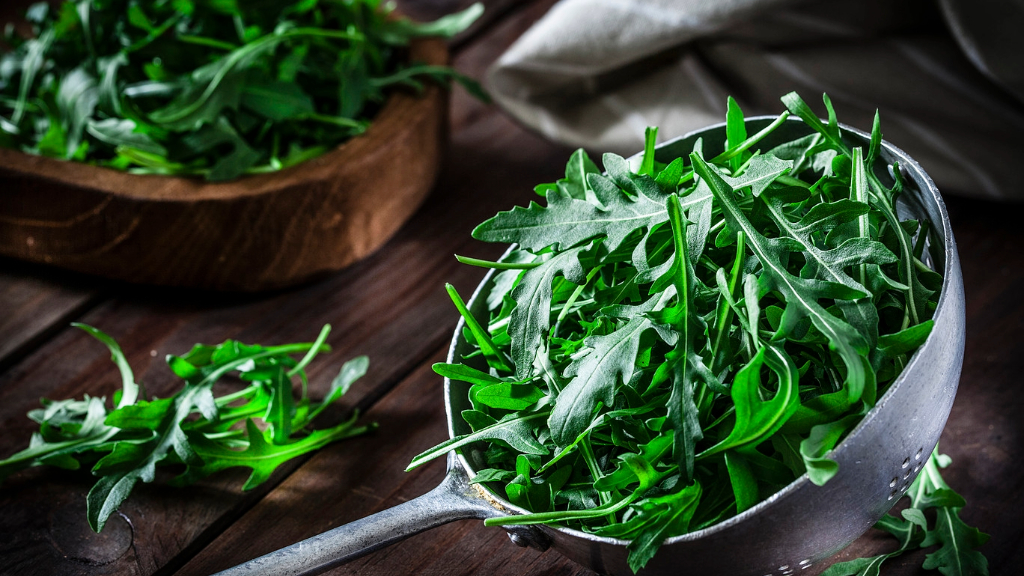Top 10 Edible Leafy Greens
Eating green means more than simple salads. Check out our favorite top 10 edible leafy greens.

There's more than one way to interpret the saying "eating green." One explanation of "eating green" is choosing and eating foods that are healthy for the planet. The other interpretation refers to eating leafy greens, which may, of course, go hand in hand with the first explanation.
If you just think leafy greens are only those that you find in your basic green salad, you may want to expand your thinking. There are so many interesting greens to choose from and all of them are rich in nutrients, full of vitamins, minerals and phytochemicals (cancer-fighting plant compounds). Plus, they taste great, are low in calories, and can be prepared in a multitude of ways.
Here are our top 10 favorites for edible leafy greens:
1. Arugula - Arugula tops the list. Larger leaves can be sautéed and lend a peppery flavor to dishes, while young leaves have a milder taste and can be eaten raw in salads. A favorite use for arugula is to use it in place of basil, or with a bit of basil, to make arugula pesto. Another favorite is goat cheese and arugula pizza!
2. Collard Greens - If you aren't from the South, you may have only read about these and for this I am sorry. Put it on your bucket list to try properly prepared southern style collard greens. They are a thing of beauty.
3. Endive - Belgian endive is oval in shape with a soft, satiny texture and a mildly bitter flavor. Shaped like a scoop, endive is the perfect vehicle for appetizers, such as dips, and is commonly used as an edible "spoon."
4. Escarole - Escarole is related to frisee (see below) and is often used in soups or paired with beans. Another Italian staple green, this mildly bitter leaf is large and crisp.
Gardening tips, videos, info and more delivered right to your inbox!
Sign up for the Gardening Know How newsletter today and receive a free copy of our e-book "How to Grow Delicious Tomatoes".
5. Frisee - Frisse has curly leaves tinged with yellow and green along with a slightly bitter flavor and crunch that adds tons of texture to green salads. The pale coloration is the result of the grower shielding them from light as they are grown.
6. Kale - Okay, I know that some people have heard enough about kale, but really, not only is it versatile and nutritious, but it is a cool-weather green that in some regions grows like a weed. And, a kale chip"¦come on!
7. Mizuna - Mizuna is a Japanese green that is often found as part of premade salad mixes. Often called spider or potherb mustard, mizuna does, indeed, have a fairly pungent flavor. It looks much like miniature oak leaves and the inclusion of mizuna adds texture to salads.
8. Rapini - Well, this one could have also gone up by arugula because it is also called broccoli rabe. It is an Italian staple that has rapidly become popular in the U.S. It tastes similar to broccoli, albeit slightly more bitter.
9. Spinach - Popeye knew what was good for him. Spinach is packed with vitamins A and C as well as folate. As spinach is cooked, its oxalate content is reduced, freeing up its calcium which means that, unlike some greens, cooked spinach is more nutrient rich than raw spinach.
10. Swiss Chard - Why Swiss chard? Because it comes in so many pretty colors! Yes, it is delicious as well, but it can also enliven an otherwise dull meal with its gorgeous hues of yellow, white, red, pink, purple and even orange.

Amy Grant has been gardening for 30 years and writing for 15. A professional chef and caterer, Amy's area of expertise is culinary gardening.
-
 Moody Blooms For Spring: 8 Types Of Black Flowers To Add Drama To Spring Displays
Moody Blooms For Spring: 8 Types Of Black Flowers To Add Drama To Spring DisplaysFrom midnight burgundies to inky violets, several types of black flowers can enrich and embolden a spring display. Try these brooding bloomers for a moody garden
By Tonya Barnett
-
 My Homemade Orchid Fertilizer Always Brings More Blooms – Here's The Easy Recipe That Transforms Plants
My Homemade Orchid Fertilizer Always Brings More Blooms – Here's The Easy Recipe That Transforms PlantsScientist-turned-gardener Mary Ellen Ellis shares her tried-and-tested DIY orchid fertilizer recipe, plus more ingredients to try for healthy, happy plants.
By Mary Ellen Ellis